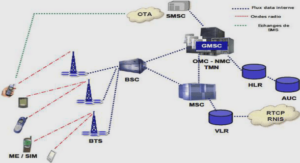Wireless sensor networks
Wireless sensor network (WSN) has attracted much attention in recent years, and it has emerged as one of the most promising technologies for the future. They are used in many applications, where a close interaction with the physical world is essential. The simple deployment and the distributed sensing properties provided by a wireless communication system make WSNs an important component of our daily lives. WSN technology offers numerous advantages over the classical existed networks, where the most important fact is the ease of deployment that allows their use in a wide range of diverse applications [1]. With advancements in this field of research and sensors getting smarter, smaller, and cheaper, a huge number of wireless sensors are being deployed in numerous applications. Some of the potential application domains are military, environment [2-4], healthcare [5-7], and security. In military [8-10], sensor nodes can be used to detect, locate, or track enemy movements everywhere and at any time. In case of natural disasters, sensor nodes can sense and detect the environment to predict disasters in advance. In healthcare, sensor nodes can help in monitoring the health of patients and also to make a remote coordination between doctors and their patients. In security, sensors can offer vigilant surveillance and increase the caution to potential terrorist attacks. A sensor network is composed of a large number of tiny devices called sensor nodes, where each node is connected to one or several sensors. Each sensor network node has typically several parts: a radio transceiver with an internal antenna or connection to an external antenna, a microcontroller, an electronic circuit for interfacing with the sensors and an energy source, usually a battery or an embedded form of energy harvesting. Sensor nodes are densely deployed either inside the phenomenon or very close to it and their position do not need to be engineered or pre-determined, this allows random deployment in inaccessible areas. On the other hand, this also means that sensor network protocols and algorithms must possess self-organizing capabilities. One of the most important constraints on sensor nodes is the low power consumption requirement. Sensor nodes have limited power sources. Therefore, while traditional networks aim to achieve high quality of service (QoS) provisions, sensor network protocols must focus primarily on power conservation. They must have inbuilt trade-off mechanisms that give the end user the option of prolonging network lifetime at the cost of lower throughput or higher transmission delay. Chapter 1: Introduction to wireless sensor networks 6 In this chapter, we will present a survey of wireless networks and focus our study on energy conservation problems. In section 1.2, we will give an overview on wireless sensor networks describing the hardware design of a sensor node and present the factors that influence on wireless sensor network functioning. Section 1.3 details the communication process for sending and receiving a specific data in the wireless sensor network. Section 1.4 focuses on energy problems and present a detailed explanation on power dissipation and the reasons of energy waste in wireless sensor networks. We will also try to give a solution to these problems by the classification of energy efficiency techniques. Finally, a general overview on wireless multimedia sensor networks and theirs characteristics is given in section 1.5.
Wireless sensor networks characteristics
The design of WSNs requires a huge knowledge of a wide variety of research fields including wireless communication, networking, embedded systems, digital signal processing, and software engineering. This is motivated by the close coupling between several hardware entities of wireless sensor devices as well as the distributed operation of a network of these devices. 1.2.1. Internal structure of a sensor node: Figure 1.1 illustrates the most common scheme of sensor node design. Also the main blocks of each sensor node are represented. Generally, it is contains on four basic components as shown in Fig. 1: a sensing unit, a processing unit, a transceiver unit and a power supply unit. They may also have application dependent additional components [11] such as a location finding system, a power generator and a mobilizer. Sensing unit: it may generally include several sensor units and each sensor unit is responsible for gathering information of certain type such as: temperature, humidity, or light… etc. they usually composed of two subunits: sensors and analog to digital converters (ADCs). The analog signals produced by the sensors based on the observed phenomenon are converted to digital signals by the ADC, and then fed into the processing unit. Processing unit: which is generally associated with a small storage unit, the processing unit manages the procedures that enable the sensor node to perform sensing operations, run associated algorithms, and collaborate with the other nodes through wireless communication [12]. Microcontrollers carry out the function of controlling all the components, and also process data received from sensing element of this sensor node, as well as data received from other sensor nodes. Microcontrollers are widely used as control elements in a sensor node, by Chapter 1: Introduction to wireless sensor networks 7 the reason of their low cost, low energy consumption, small size. And also, the ability of finding easily additional modules with various digital and even wireless interfaces, and also with the necessary performance. Transceiver unit: communication between any two wireless nodes is performed by the transceiver units. A transceiver unit implements the necessary procedures to convert bits to be transmitted into radio frequency (RF) waves and recover them at the other end. Essentially, the WSN is connected to the network through this unit. Power supply unit: One of the most important components of a sensor node is the power supply unit. Usually, battery power is used, but also other energy sources are also possible. Each component in the wireless sensor node is powered through this unit and the limited capacity requires energy-efficient operation for the tasks performed by each component [11]. Figure1.1. Hardware architecture of a sensor node Location finding system: Most of the sensor network applications, sensing tasks, and routing techniques need knowledge of the physical location of a node. This module system may consist of a GPS module for a high-end sensor node or may be a software module that implements the localization algorithms providing location information through distributed calculations. Mobilizer: A mobilizer may sometimes be needed to move sensor nodes when it is necessary to carry out the assigned tasks. Mobility support requires extensive energy resources and should be provided efficiently. Power generator: While battery power is mostly used in sensor nodes, an additional power generator can be used for applications where longer network lifetime is essential. For outdoor applications, solar cells can be used to generate power. Similarly, energy harvesting techniques for thermal, kinetic, and vibration energy can also be used [13].
Key features influencing sensor network design
Before designing any sensor node, we must take into consideration the main features and factors that affect directly the capabilities of the whole WSN. The most important of these factors are platform flexibility and scalability; production size and costs; sensor network topology; reliability; power consumption, transceiver Performances and information security. These factors [11] have been addressed by many researchers in a wide range of areas concerning the design and deployment of WSNs. Moreover, the integration of solutions for these factors is still a major challenge because of the interdisciplinary nature of this area of research. Platform flexibility and scalability: The number of sensor nodes deployed to study a phenomenon may be in the order of hundreds or thousands. Therefore, the networking protocols developed for these networks should be able to handle these large numbers of nodes. The density can range from a few to hundreds of sensor nodes in a region, which can be less than 10m in diameter. The node density depends on the application for which the sensor nodes are deployed. Moreover, the majority of real applications require flexibility and adaptability of the WSN platform. However, each sensor node platform must have the ability to be adjusted to meet the requirements of a specific application. Production size and costs: Miniaturization, price reduction and the diversity of applications are the keys that lead to the widespread use of WSNs. And since the sensor networks consist of a large number of sensor nodes, the cost of a single node is very important to justify the overall cost of the networks. If the cost of the network is more expensive than deploying traditional sensors, then the sensor network cost cannot be justified. As a result, the cost of each sensor node has to be kept low. Note that a sensor node also has some additional units such as sensing and processing units. In addition, it may be equipped with a location finding system, cameras, mobilizer, or power generator depending on the applications of the sensor networks. As a result, the cost of a sensor node is a very challenging issue and it is proportional to a given amount of functionalities. Energy consumption: The main concern for operation of WSNs is the energy consumption. For most applications, the sensor nodes are deployed in hard to access areas which make it not feasible to replace batteries of the sensor nodes. Thus, a WSN is required to operate for a long time over months or even years in order to reduce maintenance intervention and gain in time and cost.




